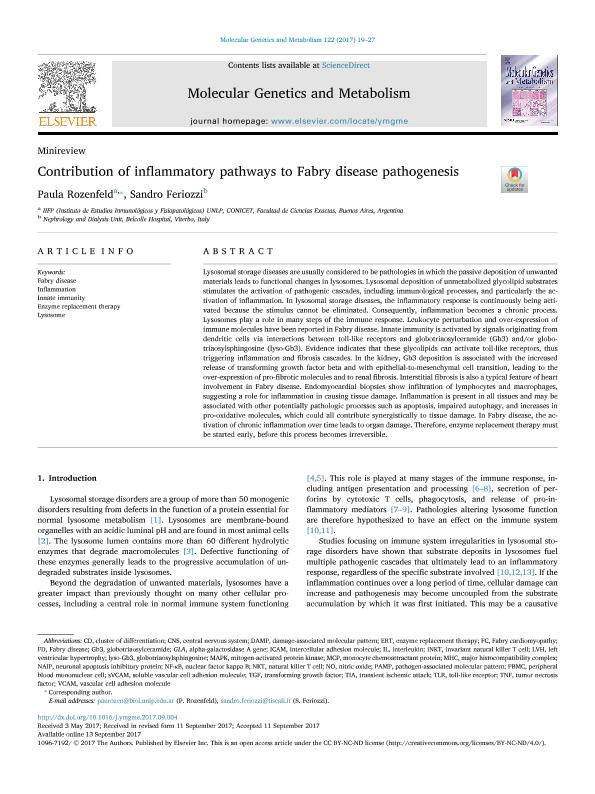Mostrar el registro sencillo del ítem
dc.contributor.author
Rozenfeld, Paula Adriana

dc.contributor.author
Feriozzi, Sandro
dc.date.available
2018-08-28T19:53:37Z
dc.date.issued
2017-11
dc.identifier.citation
Rozenfeld, Paula Adriana; Feriozzi, Sandro; Contribution of inflammatory pathways to Fabry disease pathogenesis; Academic Press Inc Elsevier Science; Molecular Genetics And Metabolism; 122; 3; 11-2017; 19-27
dc.identifier.issn
1096-7192
dc.identifier.uri
http://hdl.handle.net/11336/57425
dc.description.abstract
Lysosomal storage diseases are usually considered to be pathologies in which the passive deposition of unwanted materials leads to functional changes in lysosomes. Lysosomal deposition of unmetabolized glycolipid substrates stimulates the activation of pathogenic cascades, including immunological processes, and particularly the activation of inflammation. In lysosomal storage diseases, the inflammatory response is continuously being activated because the stimulus cannot be eliminated. Consequently, inflammation becomes a chronic process. Lysosomes play a role in many steps of the immune response. Leukocyte perturbation and over-expression of immune molecules have been reported in Fabry disease. Innate immunity is activated by signals originating from dendritic cells via interactions between toll-like receptors and globotriaosylceramide (Gb3) and/or globotriaosylsphingosine (lyso-Gb3). Evidence indicates that these glycolipids can activate toll-like receptors, thus triggering inflammation and fibrosis cascades. In the kidney, Gb3 deposition is associated with the increased release of transforming growth factor beta and with epithelial-to-mesenchymal cell transition, leading to the over-expression of pro-fibrotic molecules and to renal fibrosis. Interstitial fibrosis is also a typical feature of heart involvement in Fabry disease. Endomyocardial biopsies show infiltration of lymphocytes and macrophages, suggesting a role for inflammation in causing tissue damage. Inflammation is present in all tissues and may be associated with other potentially pathologic processes such as apoptosis, impaired autophagy, and increases in pro-oxidative molecules, which could all contribute synergistically to tissue damage. In Fabry disease, the activation of chronic inflammation over time leads to organ damage. Therefore, enzyme replacement therapy must be started early, before this process becomes irreversible.
dc.format
application/pdf
dc.language.iso
eng
dc.publisher
Academic Press Inc Elsevier Science

dc.rights
info:eu-repo/semantics/openAccess
dc.rights.uri
https://creativecommons.org/licenses/by-nc-nd/2.5/ar/
dc.subject
Enzyme Replacement Therapy
dc.subject
Fabry Disease
dc.subject
Inflammation
dc.subject
Innate Immunity
dc.subject
Lysosome
dc.subject.classification
Inmunología

dc.subject.classification
Medicina Básica

dc.subject.classification
CIENCIAS MÉDICAS Y DE LA SALUD

dc.title
Contribution of inflammatory pathways to Fabry disease pathogenesis
dc.type
info:eu-repo/semantics/article
dc.type
info:ar-repo/semantics/artículo
dc.type
info:eu-repo/semantics/publishedVersion
dc.date.updated
2018-08-28T18:43:55Z
dc.journal.volume
122
dc.journal.number
3
dc.journal.pagination
19-27
dc.journal.pais
Estados Unidos

dc.description.fil
Fil: Rozenfeld, Paula Adriana. Consejo Nacional de Investigaciones Científicas y Técnicas. Centro Científico Tecnológico Conicet - La Plata. Instituto de Estudios Inmunológicos y Fisiopatológicos. Universidad Nacional de La Plata. Facultad de Ciencias Exactas. Instituto de Estudios Inmunológicos y Fisiopatológicos; Argentina
dc.description.fil
Fil: Feriozzi, Sandro. Belcolle Hospital; Italia
dc.journal.title
Molecular Genetics And Metabolism

dc.relation.alternativeid
info:eu-repo/semantics/altIdentifier/doi/http://dx.doi.org/10.1016/j.ymgme.2017.09.004
dc.relation.alternativeid
info:eu-repo/semantics/altIdentifier/url/https://www.sciencedirect.com/science/article/pii/S1096719217302925
Archivos asociados
